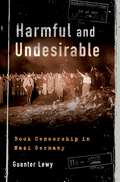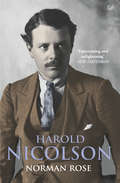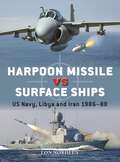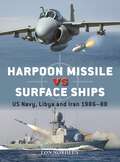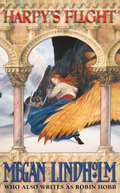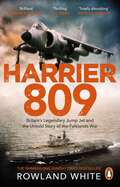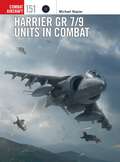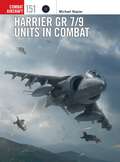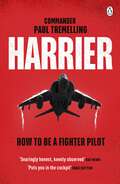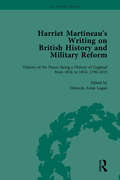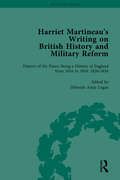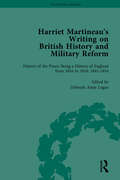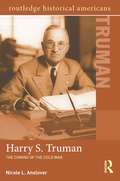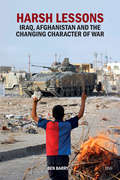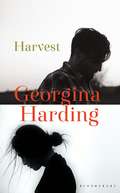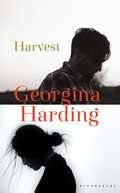- Table View
- List View
Harmful and Undesirable: Book Censorship in Nazi Germany
by Guenter LewyLike every totalitarian regime, Nazi Germany tried to control intellectual freedom through book censorship. Between 1933 and 1945, the Hitler regime orchestrated a massive campaign to take control of all forms of communication. In 1933 alone, there were 90 book burnings across 70 German cities, declared by a Ministry of Propaganda official to be "a symbol of the revolution." In later years, the regime used less violent means of domination, pillaging bookstores and libraries, in addition to prosecuting uncooperative publishers and dissident authors. Guenter Lewy deftly analyzes the various strategies that the Nazis employed to enact censorship and the government officials who led the attack on a free intellectual life. Harmful and Undesirable paints a fascinating portrait of intellectual life under Nazi dictatorship, detailing the dismal fate of those who were caught in the wheels of censorship.
Harold Nicolson
by Norman RoseHarold Nicolson was a man of extraordinary gifts. A renowned politician, historian, biographer, diarist, novelist, lecturer, journalist, broadcaster and gardener, his position in society and politics allowed him an insight into the most dramatic events of British, indeed world, history.Nicolson's personal life was no less dramatic. Married to Vita Sackville-West, one of the most famous writers of her day, their marriage survived, even prospered, despite their both being practising homosexuals. Unashamedly elitist, bound together by their literary, social, and intellectual pursuits, moving in the refined circles of the Bloomsbury group they viewed life from the rarified peaks of aristocratic haughtiness. Few men could boast such gifts as Nicolson possessed, yet he ended his life plagued by self-doubt. 'I am attempting nothing; therefore I cannot fail,' he once acknowledged. What went wrong? It was a question that haunted Nicolson throughout his adult life. Relying on a wealth of archival material, Norman Rose brilliantly disentangles fact from fiction, setting Nicolson's story of perceived failure against the wider perspective of his times.
Harpoon Missile vs Surface Ships: US Navy, Libya and Iran 1986–88 (Duel #134)
by Lon NordeenAn illustrated study of premier US anti-ship missile, the AGM/RGM-84 Harpoon, and its 1986 and '88 uses against Libyan and Iranian naval vessels.In this study, defence technology expert Lon Nordeen details the role played by the Harpoon missile in two Cold War flare-ups in the 1980s. The Harpoon was the first tactical anti-ship missile developed by the US Navy to provide a counter to the anti-ship missiles exported around the world by the Soviet Union and China. It was deployed on ships, aircraft, submarines and land vehicles and soon became the most widely used anti-ship missile system in the West, with 7,000+ having been produced since 1977, operated by the military forces of more than 30 nations. This exciting book explores the engagements of the Harpoon by the US Navy against its Libyan and Iranian adversaries, using original photographs and specially commissioned artwork to examine the naval systems and weapons employed by both counterparts. Drawing upon interviews with the US Navy A-6 Intruder crews that deployed the AGM084 variant of the Harpoon in 1986 and 1988, the author brings unique insight to his examination of these fascinating duels.
Harpoon Missile vs Surface Ships: US Navy, Libya and Iran 1986–88 (Duel #134)
by Lon NordeenAn illustrated study of premier US anti-ship missile, the AGM/RGM-84 Harpoon, and its 1986 and '88 uses against Libyan and Iranian naval vessels.In this study, defence technology expert Lon Nordeen details the role played by the Harpoon missile in two Cold War flare-ups in the 1980s. The Harpoon was the first tactical anti-ship missile developed by the US Navy to provide a counter to the anti-ship missiles exported around the world by the Soviet Union and China. It was deployed on ships, aircraft, submarines and land vehicles and soon became the most widely used anti-ship missile system in the West, with 7,000+ having been produced since 1977, operated by the military forces of more than 30 nations. This exciting book explores the engagements of the Harpoon by the US Navy against its Libyan and Iranian adversaries, using original photographs and specially commissioned artwork to examine the naval systems and weapons employed by both counterparts. Drawing upon interviews with the US Navy A-6 Intruder crews that deployed the AGM084 variant of the Harpoon in 1986 and 1988, the author brings unique insight to his examination of these fascinating duels.
Harpy’s Flight (The Ki and Vandien Quartet #1)
by Megan LindholmA reissue of classic backlist titles from the author of the best selling Farseer Trilogy and The Liveship Traders books. HARPY'S FLIGHT was Lindholm's first novel, and the first in the WINDSINGERS series, which introduced her popular gypsy characters, Ki and Vandien.
Harrier: The Biography
by Jonathan GlanceyThe British designed and built the Harrier, the most successful vertical take-off-and-landing aircraft ever made. Combining state-of-the-art fighter plane technology with a helicopter's ability to land vertically the Harrier has played an indispensable role for the RAF and Royal Navy in a number of conflicts, most famously the Falklands War. Jonathan Glancey's biography is a vividly enjoyable account of the invention of this remarkable aeroplane and a fitting tribute to the inspiration and determination of the men and women who created it, and the bravery of the men who flew it, often in the most dangerous conditions.
Harrier 809: Britain’s Legendary Jump Jet and the Untold Story of the Falklands War
by Rowland White'Utterly brilliant: a fantastically exciting book... This really does read like the best kind of thriller. His best book yet' James Holland, author of Normandy '44April 1982. Argentina invades the Falkland Islands.In response, Britain despatches a naval task force. Eight thousand miles from home, its fate hinges on just twenty Sea Harriers against the two hundred-strong might of the Argentine Air Force.The odds against them are overwhelming.The MoD's own estimates suggest that half the Harriers will be lost in the opening days of the conflict. They need backup. Within three weeks 809 Naval Air Squadron is reformed, trained and heading south, ready for war.Not since World War Two had so much been expected of such a small band of pilots.
Harrier GR 7/9 Units in Combat (Combat Aircraft #151)
by Michael NapierFormer RAF Tornado pilot Michael Napier chronicles the action-packed history of the Harrier GR 7/9, and its missions in West Africa, the Balkans, the Middle East and Afghanistan over a 14-year period of ceaseless operations. The Harrier GR 7/9 was at the 'tip of the spear' for the RAF when it came to employing weapons against well-equipped standing armies and irregular forces in the 1990s and during the first decade of the new millennium. Assigned to the Harrier GR 7/9 Force, the aircraft undertook No Fly Zone patrols over northern Iraq, supported UN forces in the Balkans and embarked in Royal Navy carriers to bolster the RAF presence ashore in the Arabian Gulf. Harrier GR 7s also flew from HMS Illustrious over Sierra Leone in 2000 and were involved in the second Gulf War during early 2003 acting as Close Air Support for Coalition forces. Using first-hand accounts from his extensive Service contacts, supported by both official and personal photographs and 30 artwork profiles illustrating the wide range of colours worn and ordnance employed by the 'jump jet', Michael Napier provides a rare insider's look at the deployment of Harrier GR 7/9 up to its withdrawal from RAF service in 2010. Moreover, Napier also covers the numerous upgrades received by the aircraft over the years, from more powerful engines to the creation of the GR 9/9A variants in 2005.
Harrier GR 7/9 Units in Combat (Combat Aircraft #151)
by Michael NapierFormer RAF Tornado pilot Michael Napier chronicles the action-packed history of the Harrier GR 7/9, and its missions in West Africa, the Balkans, the Middle East and Afghanistan over a 14-year period of ceaseless operations. The Harrier GR 7/9 was at the 'tip of the spear' for the RAF when it came to employing weapons against well-equipped standing armies and irregular forces in the 1990s and during the first decade of the new millennium. Assigned to the Harrier GR 7/9 Force, the aircraft undertook No Fly Zone patrols over northern Iraq, supported UN forces in the Balkans and embarked in Royal Navy carriers to bolster the RAF presence ashore in the Arabian Gulf. Harrier GR 7s also flew from HMS Illustrious over Sierra Leone in 2000 and were involved in the second Gulf War during early 2003 acting as Close Air Support for Coalition forces. Using first-hand accounts from his extensive Service contacts, supported by both official and personal photographs and 30 artwork profiles illustrating the wide range of colours worn and ordnance employed by the 'jump jet', Michael Napier provides a rare insider's look at the deployment of Harrier GR 7/9 up to its withdrawal from RAF service in 2010. Moreover, Napier also covers the numerous upgrades received by the aircraft over the years, from more powerful engines to the creation of the GR 9/9A variants in 2005.
Harrier: How To Be a Fighter Pilot
by Paul TremellingDiscover the exhilarating first-hand account of one man's white-knuckle life as a fighter pilot with the Royal Navy Sea Harriers'Searingly honest, keenly observed, well written and extremely funny' RAF NEWS'Puts you in the cockpit for carrier landings, missile firings and some of the most intense close air support stories imaginable' MIKE SUTTON____________Few have what it takes to be a fighter pilot. From the cockpit to the crew room, the pressure is relentless. One mistake is the difference between life and death. But in the air, you'll never feel more alive . . .Paul Tremelling knows this better than anyone. With nearly 20 years of experience, he puts you in the pilot's seat in this thrilling first-hand account of a life in combat.From saving the lives of heroes under fire in Afghanistan, to performing a night trap on a pitching aircraft carrier deck, this is life as you've never experienced it before.Strap in, it's time for take-off . . .____________'An outstanding first-hand account from inside the cockpit, told with flair and humour' JOHNNY MERCER MP, author of We Were Warriors'The storytelling wouldn't be out of place in a thriller. If you are going to take one book on holiday it has to be Harrier . . . it's a superb read. You won't be able to put it down' Aerospace'Mad, bad and dangerous to know . . . Tremelling lights the burners in an extraordinary memoir that leaves most military memoirs sitting behind in the hangar' JAMES BRABAZON, author of My Friend the Mercenary'This isn't a book for the faint-hearted. It is a book for anyone who appreciates insight into how a fighter pilot trains, trains more, thinks (fast), handles the aircraft and onboard tech . . . then fights' FLYER'Tremmers puts you in the cockpit for carrier landings, missile firings and some of the most intense close air support sorties imaginable. Insightful, laced with humour, and highly recommended' MIKE SUTTON, author of Typhoon'An inspiring, enlightening and thrilling insight into how modern aviators earn their pay. The stories from Afghanistan alone are justification enough to read this brilliant book. A masterpiece' PAUL BEAVER, author of Spitfire People 'A memoir that reads like a fast-paced thriller. Harrier launches straight onto the classics shelf of aviation literature' JOHN TEMPLETON SMITH, author of White Lie
Harriet Martineau's Writing on British History and Military Reform, vol 1
by Deborah Logan Kathryn SklarThis volume contains Harriet Martineau's writings on the history of England and its efforts and negotiations to promote peace between 1790 and 1815, providing a detailed account of the political revolutions and democratic and military reforms that shaped England's history.
Harriet Martineau's Writing on British History and Military Reform, vol 1
by Deborah Logan Kathryn SklarThis volume contains Harriet Martineau's writings on the history of England and its efforts and negotiations to promote peace between 1790 and 1815, providing a detailed account of the political revolutions and democratic and military reforms that shaped England's history.
Harriet Martineau's Writing on British History and Military Reform, vol 3
by Deborah Logan Kathryn SklarThis volume contains Harriet Martineau's writings on the history of England and its efforts and negotiations to promote peace between 1826 and 1834, providing a detailed account of the political revolutions and democratic and military reforms that shaped England's history.
Harriet Martineau's Writing on British History and Military Reform, vol 3
by Deborah Logan Kathryn SklarThis volume contains Harriet Martineau's writings on the history of England and its efforts and negotiations to promote peace between 1826 and 1834, providing a detailed account of the political revolutions and democratic and military reforms that shaped England's history.
Harriet Martineau's Writing on British History and Military Reform, vol 5
by Deborah Logan Kathryn SklarThis volume contains Harriet Martineau's writings on the history of England and its efforts and negotiations to promote peace between 1841 and 1854, providing a detailed account of the political revolutions and democratic and military reforms that shaped England's history.
Harriet Martineau's Writing on British History and Military Reform, vol 5
by Deborah Logan Kathryn SklarThis volume contains Harriet Martineau's writings on the history of England and its efforts and negotiations to promote peace between 1841 and 1854, providing a detailed account of the political revolutions and democratic and military reforms that shaped England's history.
Harry S. Truman: The Coming of the Cold War (Routledge Historical Americans)
by Nicole L. AnsloverHarry S. Truman presided over one of the most challenging times in American history—the end of World War II and the onset of the Cold War. Thrust into the presidency after Franklin D. Roosevelt died in office, Truman oversaw the transition to a new, post-war world in which the United States wielded the influence of a superpower. With his humble beginnings and straightforward manner, Truman was the personification of a typical American. As president, however, he dealt with decisions that were anything but typical. His presidency saw the decision to drop the atomic bomb, the integration of the military, and the development of an interventionist foreign policy aimed at ‘containing’ Communism, from providing aid in the Marshall Plan to entering the Korean War. In the post-Cold War era, Harry S. Truman: The Coming of the Cold War provides insight into a pivotal moment in history that laid the foundations of today’s politics and international relations. In this concise and accessible biography, Nicole L. Anslover addresses the president’s political and personal life to explore the lasting impact that Truman had on American society and America’s role in the world. Supplemented by a diverse array of primary documents, including presidential addresses, private letters, and political cartoons, this narrative presents a key American figure to students of history and politics.
Harry S. Truman: The Coming of the Cold War (Routledge Historical Americans)
by Nicole L. AnsloverHarry S. Truman presided over one of the most challenging times in American history—the end of World War II and the onset of the Cold War. Thrust into the presidency after Franklin D. Roosevelt died in office, Truman oversaw the transition to a new, post-war world in which the United States wielded the influence of a superpower. With his humble beginnings and straightforward manner, Truman was the personification of a typical American. As president, however, he dealt with decisions that were anything but typical. His presidency saw the decision to drop the atomic bomb, the integration of the military, and the development of an interventionist foreign policy aimed at ‘containing’ Communism, from providing aid in the Marshall Plan to entering the Korean War. In the post-Cold War era, Harry S. Truman: The Coming of the Cold War provides insight into a pivotal moment in history that laid the foundations of today’s politics and international relations. In this concise and accessible biography, Nicole L. Anslover addresses the president’s political and personal life to explore the lasting impact that Truman had on American society and America’s role in the world. Supplemented by a diverse array of primary documents, including presidential addresses, private letters, and political cartoons, this narrative presents a key American figure to students of history and politics.
Harry’s War
by Harry Drinkwater Jon Cooksey David Griffiths‘I saw several fellows fall, one fellow coughing up blood and all the time, bullets were hacking about me. I ran for about 70 yards carrying with me all the Lewis gun things I had brought up and dropped breathless into a shell hole headlong onto a German who had been dead for months.’Harold Drinkwater was not supposed to go to war. He was told he was half an inch too short. But, determined to fight for king and country, he found a battalion that would take him and was soon on his way to the trenches of the Somme. As the war dragged on, Harry saw most of the men he joined up with killed around him. But, somehow, he survived.Soldiers were forbidden from keeping a diary so Harry wrote his in secret, recording the horrendous conditions and constant fear, as well as his pleasure at receiving his officer's commission, the joy of his men when they escaped the trenches for the Italian Front and the trench raid for which he was awarded the Military Cross. Harry writes with such immediacy it is easy to forget that a hundred years have passed. He is by turns wry, exhausted, annoyed, resigned and often amazed to be alive. Never before published, Harry's War is a moving testament to one man's struggle to keep his humanity in the face of unimaginable violence.
Harsh Lessons: Iraq, Afghanistan and the Changing Character of War (Adelphi series)
by Ben BarryThe recent Afghanistan and Iraq wars were very controversial. The conflicts’ casualties, intractability and the apparent failure of the US and its allies to achieve their objectives mean that many see the wars as failures. This resulted in a loss of confidence in the West of the utility of force as an instrument of state power. Both wars have been well described by journalists. There is no shortage of memoirs. But there is little discussion of how the conduct of these wars and capabilities of the forces involved changed and evolved, and of the implications of these developments for future warfare. This book gives readers a clear understanding of the military character dynamics of both wars and how these changed between 2001 and 2014. This includes the strategy, operations, tactics and technology of the forces of the US and its allies, Afghan and Iraqi government forces as well as insurgents and militias, showing how they evolved over time. Many of these developments have wider relevance to future conflicts. The book identifies those that are of potential wider application to US, NATO and other western forces, to insurgents, as well as to forces of states that might choose to confront the west militarily.
Harsh Lessons: Iraq, Afghanistan and the Changing Character of War (Adelphi series)
by Ben BarryThe recent Afghanistan and Iraq wars were very controversial. The conflicts’ casualties, intractability and the apparent failure of the US and its allies to achieve their objectives mean that many see the wars as failures. This resulted in a loss of confidence in the West of the utility of force as an instrument of state power. Both wars have been well described by journalists. There is no shortage of memoirs. But there is little discussion of how the conduct of these wars and capabilities of the forces involved changed and evolved, and of the implications of these developments for future warfare. This book gives readers a clear understanding of the military character dynamics of both wars and how these changed between 2001 and 2014. This includes the strategy, operations, tactics and technology of the forces of the US and its allies, Afghan and Iraqi government forces as well as insurgents and militias, showing how they evolved over time. Many of these developments have wider relevance to future conflicts. The book identifies those that are of potential wider application to US, NATO and other western forces, to insurgents, as well as to forces of states that might choose to confront the west militarily.
Harvest
by Georgina HardingSo fresh and free she looked, in the yellow dress. Sunlight to blaze away the shadows. A farm in Norfolk in the 1970s. A Japanese girl comes to visit her English lover in the house where he was born. She arrives on a day of perfect summer, stands with his mother in a garden filled with roses, watches as his brother walks fields of ripening wheat.But between the two brothers lies the shadow of their father's violent death almost twenty years before, the unresolved narrative of their childhood – a story that has gone untold, a story that began in the last war. In the presence of the girl, the old trauma begins to surface as the work of the harvest begins.In a compelling addition to Harding's cycle of acclaimed novels on themes of witness, memory and silence, on what goes unsaid long after wars are over, Harvest tells how a family reaps the consequences of its past.
Harvest
by Georgina Harding'I would compare her to writers like Helen Dunmore, Elizabeth Strout, Jon McGregor' BBC Radio 4'Harding achieves a weighty sense of silence and things not said in this unsettling book about the aftershocks of trauma and the burdens of bearing witness' Sunday Times'A masterly achievement, illuminating with wisdom and compassion the darkest corners of the human heart' GuardianSo fresh and free she looked, in the yellow dress. Sunlight to blaze away the shadows. A farm in Norfolk in the 1970s. A Japanese girl comes to visit her English lover in the house where he was born. She arrives on a day of perfect summer, stands with his mother in a garden filled with roses, watches as his brother walks fields of ripening wheat.But between the two brothers lies the shadow of their father's violent death almost twenty years before, the unresolved narrative of their childhood – a story that has gone untold, a story that began in the last war. In the presence of the girl, the old trauma begins to surface as the work of the harvest begins.In a compelling addition to Harding's cycle of acclaimed novels on themes of witness, memory and silence, on what goes unsaid long after wars are over, Harvest tells how a family reaps the consequences of its past.'Taut and unsettling ... A fine meditation on war's long reach' Mail on Sunday
Harvest of Despair: Life and Death in Ukraine under Nazi Rule
by Karel C. Berkhoff“If I find a Ukrainian who is worthy of sitting at the same table with me, I must have him shot,” declared Nazi commissar Erich Koch. To the Nazi leaders, the Ukrainians were Untermenschen—subhumans. But the rich land was deemed prime territory for Lebensraum expansion. Once the Germans rid the country of Jews, Roma, and Bolsheviks, the Ukrainians would be used to harvest the land for the master race. Karel Berkhoff provides a searing portrait of life in the Third Reich’s largest colony. Under the Nazis, a blend of German nationalism, anti-Semitism, and racist notions about the Slavs produced a reign of terror and genocide. But it is impossible to understand fully Ukraine’s response to this assault without addressing the impact of decades of repressive Soviet rule. Berkhoff shows how a pervasive Soviet mentality worked against solidarity, which helps explain why the vast majority of the population did not resist the Germans. He also challenges standard views of wartime eastern Europe by treating in a more nuanced way issues of collaboration and local anti-Semitism. Berkhoff offers a multifaceted discussion that includes the brutal nature of the Nazi administration; the genocide of the Jews and Roma; the deliberate starving of Kiev; mass deportations within and beyond Ukraine; the role of ethnic Germans; religion and national culture; partisans and the German response; and the desperate struggle to stay alive. Harvest of Despair is a gripping depiction of ordinary people trying to survive extraordinary events.
Harvest of Thorns
by Shimmer ChinodyaHarvest of Thorns tells the powerful story of Benjamin, a young soldier returned from the frontlines of the Zimbabwe Civil War, forced to ask himself what it means to be free in the new Zimbabwe. Isolated and troubled at boarding school, Benjamin is fascinated by the idea of fighting for the liberation of Rhodesia and transforming it into an independent nation. But upon returning home from the war, he quickly discovers that independence has come at a great cost and that little has changed in his small town. While facing the realities of post-revolution life, Benjamin tries to find happiness in a desperate situation. Shimmer Chinodya unravels the extraordinary story of Zimbabwe's liberation through masterful storytelling, exploring the profound effects liberation had on society as well as at the level of the individual. 'Remarkable.' Chimamanda Ngozi Adichie'A brutal, honest account of the freedom fighter's struggle for independence in Zimbabwe.' Guardian 'A humane and penetrating look at a brutal government and a bloody revolution.' Publishers Weekly
